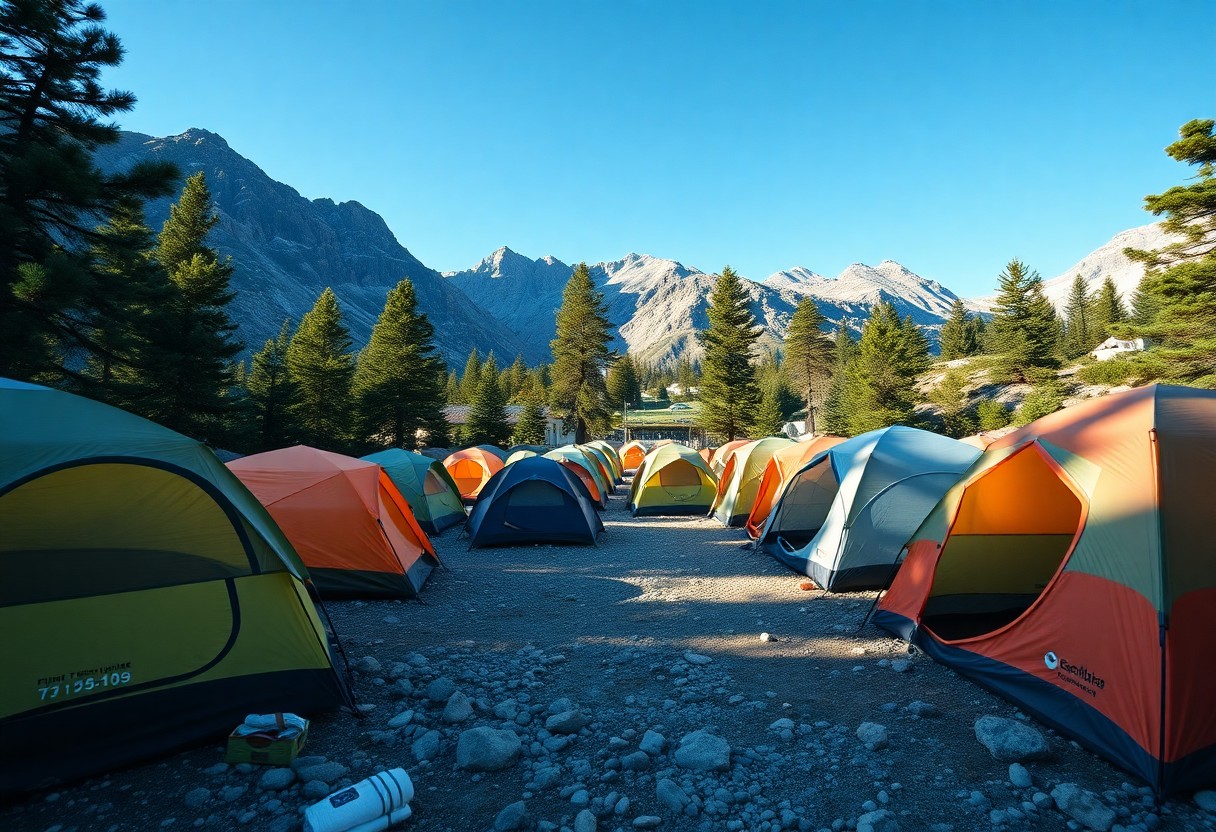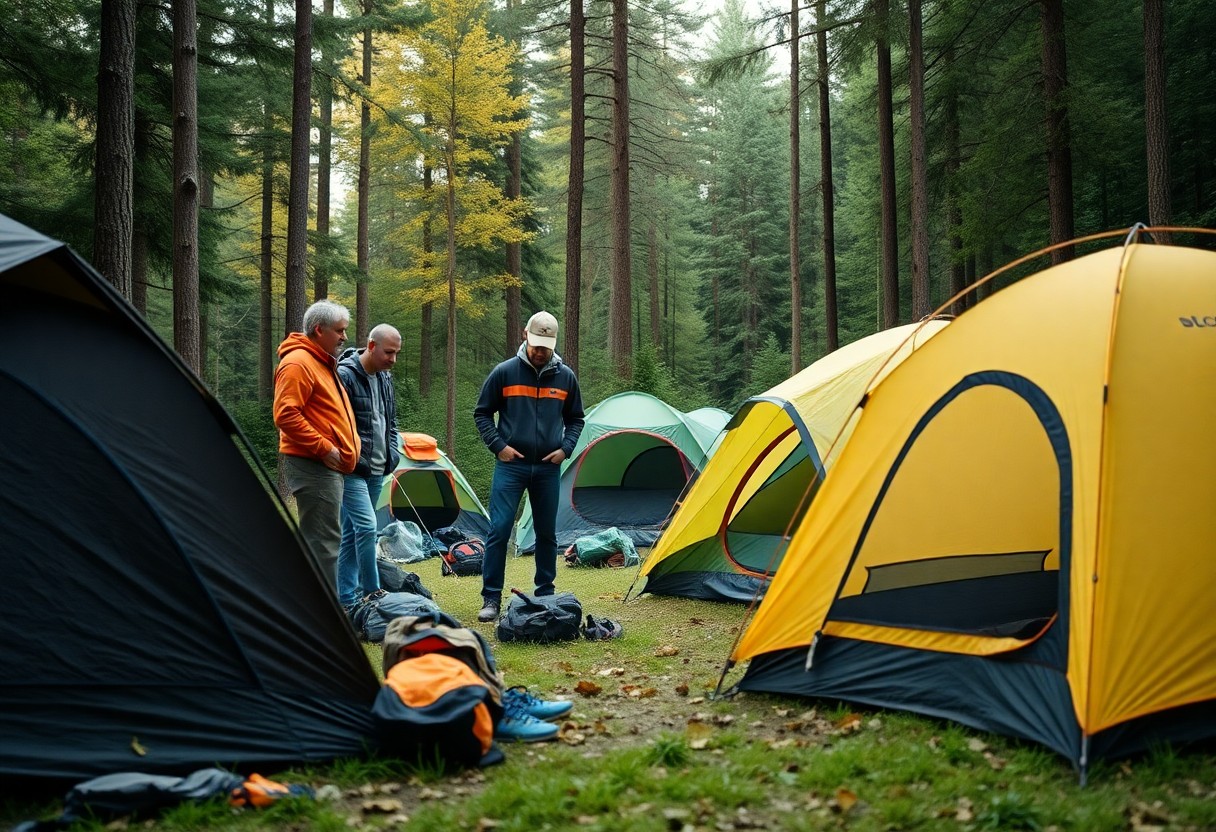Tents are your imperative shelter while immersing yourself in nature, but selecting the right one can feel overwhelming. With numerous options available, you must consider factors such as weather resistance, size, and ease of setup to ensure a safe and enjoyable experience. Whether you’re begining on a weekend adventure or a lengthy expedition, choosing the perfect camping tent is vital for your comfort and protection. This guide will equip you with the knowledge needed to make an informed decision for any camping trip.
Contents
- 1 Decoding Tent Specifications
- 2 Performance Under Pressure: Evaluating Tent Features
- 3 Navigating the Wilderness: Terrain and Climate Considerations
- 4 Budgeting for Your Adventure: Cost versus Value
- 5 Real-World Testing: Insights from Experienced Campers
- 6 Final Words
- 6.0.1 Q: What should I consider when selecting a camp tent size?
- 6.0.2 Q: What types of tents are best for different camping conditions?
- 6.0.3 Q: How important is tent material for durability and weather resistance?
- 6.0.4 Q: What features should I look for in a camping tent for convenience?
- 6.0.5 Q: How can I maintain and clean my camping tent for longevity?
Key Takeaways:
- Determine the tent size based on the number of occupants and their gear for optimal comfort.
- Consider the tent’s material and weather resistance to ensure it can withstand varying environmental conditions.
- Evaluate additional features, such as waterproofing, weight, and ease of setup, to enhance your camping experience.
- Research tent designs, including dome, cabin, and backpacking options, to find the best fit for your trip type.
- Set a budget that balances quality and price without compromising necessary features for your camping needs.
Decoding Tent Specifications
Understanding tent specifications empowers you to select the right shelter for your adventures. Key features include the material, weight, packability, season rating, and dimensions. Each element plays a significant role in ensuring you remain comfortable and dry during your trip. By familiarizing yourself with these terms and features, you can make informed choices that align with your camping needs and conditions.
Material Matters: What Makes a Tent Weatherproof?
Weatherproofing hinges on the tent’s fabric and coating. Typically, fabrics like polyester and nylon, with a polyurethane or silicone coating, provide excellent resistance against rain and UV exposure. A higher denier count indicates stronger fabric, while a waterproof rating above 1,500mm is advisable for wet conditions. Additionally, sealed seams prevent water leaks, ensuring your shelter remains dry inside.
Size Does Count: How to Choose the Right Capacity
Selecting the right size tent requires considering both occupant count and gear storage. Tent capacity is often denoted by the number of sleepers it can accommodate; however, a four-person tent may be suitable for only two if you also plan to store equipment inside. For ultimate comfort, plan for approximately 30 square feet per person and allow additional room for gear.
When deciding on the tent capacity, think about your specific camping style and group dynamics. A two-person tent might suffice for a romantic getaway, but if you enjoy spacious accommodations or are traveling with kids or bulky gear, a larger tent can dramatically enhance your experience. For instance, if you often find yourself sharing your tent with extra gear or pets, opt for a size that exceeds your occupancy needs. This way, you create a more pleasant environment that doesn’t feel cramped or crowded during those long nights under the stars.
Performance Under Pressure: Evaluating Tent Features
Choosing a camping tent requires assessing various features that not only affect your comfort but also its performance in different conditions. Consider factors like durability, fabric quality, weather resistance, and ease of setup. Look for materials like ripstop nylon for lightweight strength and features such as waterproof coatings and sturdy pole structures, which ensure your tent can withstand rough weather. Additionally, check the tent’s setup time; an intuitive design can save you frustration after a long day of hiking or during unexpected storms.
Ventilation Versus Insulation: Finding the Right Balance
Strategic ventilation and insulation elements can significantly impact your camping experience. A tent with adequate ventilation minimizes condensation issues, crucial on warmer nights, while insulated models offer warmth during colder conditions. Consider mesh panels, adjustable vents, and double-wall construction for effective airflow. This balance ensures you stay comfortable throughout your trip, regardless of unpredictable weather changes.
Packability and Weight: The Backpacker’s Dilemma
Every ounce counts when it comes to backpacking, making the weight and packability of your tent highly relevant. Lightweight tents typically weigh between 2 to 5 pounds, ideal for those long-distance hikes. However, finding a compact option that doesn’t sacrifice durability can be tricky. Consider whether you’re willing to compromise on features for ultra-lightweight designs, or if a bit more weight can provide extra comfort and durability on your outdoor adventures.
Your choice in packability and weight directly influences the gear load you carry on your hike. Many reputable brands offer tents with innovative materials, like Dyneema or Si Fiber, which can significantly reduce weight without compromising strength or water resistance. Opting for a tent with a smaller footprint can also enhance its transportability. While ultralight models may be enticing, look for ones that include a minimal degree of weather protection and living space without straining your limits; balancing comfort and efficiency becomes your top priority as you traverse the trails.

As you prepare for your camping adventure, understanding the distinct terrain and climate of your chosen location will greatly influence your tent selection. Different environments pose unique challenges; for instance, rugged mountain regions may require tents with better stability and wind resistance, while beach camping calls for tents with UV protection and sand stakes for anchoring. In addition, considering seasonal changes is imperative as it affects temperature and weather patterns, paving the way for more informed decisions about insulation, ventilation, and water resistance.
Camping in the Heat: Tips for Hot Weather Tents
Staying cool during hot weather camping requires selecting the right tent and strategic planning. For comfort, look for tents made from breathable materials, preferably with mesh panels for ventilation. It’s wise to set up your tent in shaded areas, and choose lighter colors to reflect the sun. Additionally, incorporating a rainfly can help in reducing heat as it provides extra insulation. A few key points include:
- Opt for breathable fabrics to encourage airflow
- Choose tents with mesh windows for ventilation
- Set up in shaded areas to minimize direct sunlight
- Consider tents with a rainfly to cool the interior
After ensuring proper airflow, consider using reflective tarps or canopies to enhance your cooling strategies.
Bracing for the Elements: Tents Designed for Cold and Rain
Selecting the right tent for cold and rainy conditions means ensuring that you have a sturdy shelter that can withstand harsh weather. Look for tents that feature a low-profile design for wind resistance, with materials that offer thermal insulation. Tents with waterproof capabilities, such as a rainfly that extends to the ground and sealed seams, provide excellent protection against wet conditions. Pay attention to features like snow flaps for snow camping and vestibules for gear storage during inclement weather. A solid option would be four-season tents, specifically built to hold up against the harshest conditions.
Four-season tents often come equipped with extra poles for stability in strong winds and can handle heavy snow loads. Certain models also have improved ventilation systems designed to minimize condensation inside the tent. With careful consideration of materials and construction, you can ensure that your shelter will keep you warm and dry, even in severe weather. Choosing a tent that boasts high waterproof ratings along with thermal warmth can make all the difference in your outdoor experience when facing the elements.
Budgeting for Your Adventure: Cost versus Value
Finding the right balance between cost and value is vital when selecting a camping tent that meets your needs. Many tents come with varying price points, and while a lower-priced option might seem appealing at first, it’s vital to consider how that tent will hold up during your adventures. Investing a bit more upfront can save you money in the long run—think about factors like durability, weather resistance, and included features that enhance your overall camping experience. Prioritize tents that offer the best value for your specific needs and the conditions you’ll encounter.
Understanding MSRP: What Price Really Tells You
The Manufacturer’s Suggested Retail Price (MSRP) serves as a baseline for what a tent is worth in the market. However, discounts and regional price differences can significantly affect the final purchase cost. Look beyond the MSRP and examine the tent’s specifications, materials, and customer reviews to gauge its true value. A higher MSRP can indicate better quality, but don’t overlook moderately priced tents that outperform their price tag in specific conditions.
Long-Term Investment: When to Choose Quality Over Cost
Some camping trips are fleeting experiences while others can become annual traditions; evaluating how often you plan to use your tent helps in deciding between quality and cost. If you camp frequently, investing in a high-quality tent can pay off in divinely comfort and durability. Premium tents boast enhanced materials that resist wear and tear, keeping you safe from harsh elements. Additionally, reputable brands often offer better warranties, further solidifying your investment and ensuring peace of mind for countless trips ahead.
It’s tempting to settle for a budget tent, but think about the long-term benefits of selecting a quality product. For instance, a durable tent made from tear-resistant fabrics and waterproof coatings can last for years, withstand the rigors of the outdoors, and maintain its performance under various conditions. Imagine yourself on a rainy weekend trip, snug and dry inside a high-quality tent while others struggle to stay sheltered in flimsy alternatives. The peace of mind—and comfort—you gain from a solid investment can transform your camping experiences and keep you coming back for more adventures.

Real-World Testing: Insights from Experienced Campers
Many seasoned campers have invaluable insights shaped by years of experience in diverse environments. Their real-world testing reveals which tents withstand harsh conditions and which fail under pressure. For instance, stories abound of tents that defied heavy rain and strong winds while others struggled to keep occupants dry. You can benefit from these firsthand accounts to avoid common pitfalls and refine your own tent selection process. Integration of these lessons allows you to make informed decisions based on practical trials rather than just marketing claims.
The Lessons Learned: Stories from the Trail
Some campers have experienced tent drama that shaped their gear choices. One camper recounted a night in a lightweight tent that collapsed during a storm, leaving them unshielded in freezing temperatures. Others have praised specific models for their ease of setup and space efficiency. These stories not only highlight the importance of durability but also emphasize how crucial it is to match your tent choice with the anticipated weather conditions and terrain.
Reviews and Recommendations: What the Pros Use
With respect to choosing the right tent, insights from professionals can guide you toward the best options. Many outdoor experts favor tents from reputable brands known for their durability and performance. For example, the REI Half Dome series and Big Agnes Copper Spur have consistently earned high marks for their reliability in various conditions. Pros often highlight the importance of materials such as rainfly and floor fabric to ensure water resistance and longevity, making it easier for you to pick a trusted model.
The REI Half Dome series is praised for its versatility, offering ample space and a user-friendly setup that appeals to both beginners and seasoned campers. Similarly, the Big Agnes Copper Spur is frequently recommended for its balance of weight and durability, making it a favorite for backpackers. Professionals emphasize the significance of features like ventilation systems and weather resistance when choosing a tent, as these can significantly impact your camping experience in unpredictable conditions. Paying attention to expert reviews enables you to select a tent that not only meets your checklist but also performs superbly on the trails.
Final Words
The perfect camping tent can greatly enhance your outdoor experience, making your adventures more comfortable and enjoyable. By understanding the different types, sizes, and features available, you’ll be able to select a tent that meets your specific needs for any trip. Take the time to assess your requirements and consider factors such as weather conditions, group size, and portability. With the right preparation and knowledge, you’ll ensure that your camping trips are memorable for all the right reasons.
Q: What should I consider when selecting a camp tent size?
A: When choosing a tent size, consider the number of occupants it needs to accommodate comfortably. Manufacturers often include the maximum number of people a tent can fit, but for a more enjoyable experience, opt for a tent that allows for extra space. Also, think about your gear; a larger tent can provide additional room for equipment, while a smaller tent may promote coziness.
Q: What types of tents are best for different camping conditions?
A: Different camping conditions warrant specific types of tents. For example, lightweight backpacking tents are suited for hiking trips where weight matters. If camping in a rainy or windy area, look for four-season tents designed to withstand harsh weather. For family camping trips, consider cabin-style tents that offer more space and comfort. Assess the climate and terrain of your camping destination to select the appropriate tent type.
Q: How important is tent material for durability and weather resistance?
A: Tent material plays a significant role in its durability and resistance to weather elements. Common materials include nylon and polyester, both of which differ in their strength and weight. Look for tents with a higher denier fabric for better durability. Additionally, the waterproof coating, often rated in mm, indicates its rain resistance; a higher number typically means better protection against the weather.
Q: What features should I look for in a camping tent for convenience?
A: When evaluating tents for convenience, consider features like ease of setup, which can often be simplified with color-coded poles or instant pop-up designs. Ventilation is another crucial factor; tents with mesh windows and roof vents help control condensation. Additional conveniences might include built-in pockets for storage, vestibules for gear protection, and detachable rainflies for enhanced weather adaptability.
Q: How can I maintain and clean my camping tent for longevity?
A: To ensure your tent lasts, regular maintenance is vital. After each use, shake out debris and dirt. Cleaning the tent involves using a soft sponge and a mild soap solution to gently remove stains and grime. Avoid immersing the tent completely in water, and always let it air dry thoroughly before storing to prevent mold and mildew. Store your tent in a cool, dry place, and avoid prolonged exposure to direct sunlight to prevent fabric degradation.



